


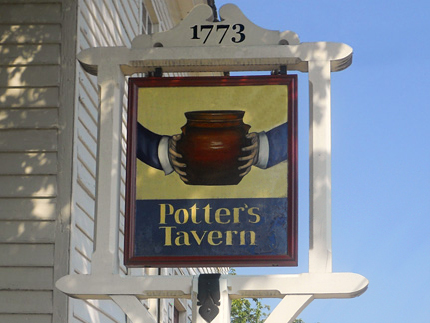
Potter's Tavern
49-51 West Broad St.
Map / Directions to Potter's Tavern
Map / Directions to all Bridgeton Revolutionary War Sites
For tour information,see the Cumberland County Historical Society website: www.cchistsoc.org
Matthew Potter and Potter's Tavern
Potter's Tavern was owned by Matthew Potter, who was born in Ireland in 1734. His family immigrated to America when Matthew was a youth, first to Connecticut and then to Philadelphia. He later moved to Bridgeton, where he ran a tavern in this building, which also contained his blacksmith shop. His brother David Potter was a Revolutionary War militia colonel. [1]
Taverns at the time served multiple purposes. In addition to serving alcohol and food, they offered lodging to travelers. They also served as places for a wide range of public functions, including town meetings, legal courts, and elections. [2]
The Plain-Dealer [3]
Potters Tavern not only provided a place for local citizens to discuss matters, it also provided a home for what is sometimes described as New Jersey's first newspaper, the Plain-Dealer. From December 25, 1775 until February 12, 1776, eight weekly handwritten editions of the Plain-Dealer appeared in the tavern. It contained short articles written by Cumberland County citizens commenting on issues of the day, many of which concerned the early Revolutionary War. Local residents were welcome to stop by the tavern to read the Plain-Dealer at Potter's Tavern. They were not allowed to remove the Plain-Dealer from the tavern, but they were welcome to handwrite their own copies to take with them.
The articles in the Plain-Dealer were written anonymously or under pseudonyms. Among those who are believed to have contributed to the Plain-Dealer were the future third- and fourth-elected governors of New Jersey, Richard Howell and Joseph Bloomfield. Several of the believed contributors including Jonathan Elmer, Lewis Howell, and the aforementioned Richard Howell, took part in the Greenwich Tea Burning.
Although the Plain-Dealer may not have been a newspaper by modern standards, it did serve the purpose of keeping local residents informed during the tumultuous period of the early Revolutionary War, and it maintained a weekly schedule for eight weeks.
Two "real" newspapers would begin publication in New Jersey during the next several years of the Revolutionary War. The first was The New Jersey Gazette, which began publication in Burlington in 1777 and then later moved to Trenton. The second was the New Jersey Journal, which began publication in Chatham in 1779.

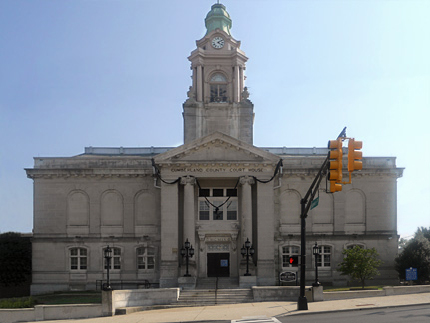
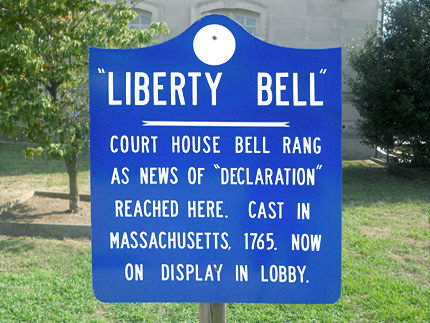
Cumberland County Courthouse
60 W Broad St
Map / Directions to the Cumberland County Courthouse
Map / Directions to all Bridgeton Revolutionary War Sites
The Cumberland County Courthouse building which stands here today was built in 1909-1910. [4] It stands on Broad Street, where a number of earlier church buildings stood.
The courthouse which stood here during the Revolutionary War was the site of a public reading of the Declaration of Independence on Aug 7, 1776, just over a month after it was ratified on July 4th. A newspaper article published several weeks later described the occasion: [5]
"The Committee of Inspection for the county of Cumberland, in the State of New-Jersey, the officers of the militia, & a great number of other inhabitants, having met at Bridge-Town, went into procession to the Court House, where the Declaration of Independency, the Constitution of New Jersey, and Treason Ordinance, were publicly read, and unanimously approved of: These were followed with a spirited address by Dr. Elmer, Chairman of the Committee, after which the peace officers staves, on which were depicted the King's coats of arms, with other ensigns of royalty, were burnt in the street. The whole was conducted with the greatest decency and regularity." (Dr. Elmer is buried in the Historic Broad Street Cemetery shown below; he was one of the Greenwich Tea Burners.)
The courthouse bell that rang out during the events of that day is now displayed in the lobby of the current courthouse. [6]

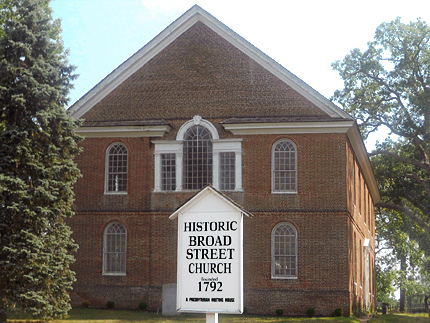
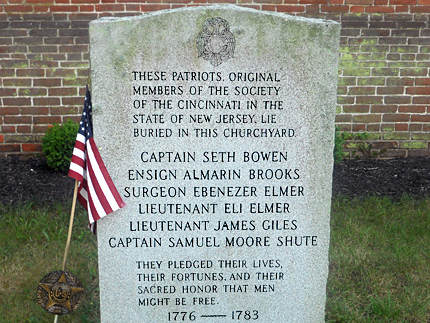
Historic Broad Street Church Cemetery
Shiloh Pike intersection with St. Lawrence St. and West Broad St.
Map / Directions to the Historic Broad Street Church Cemetery
Map / Directions to all Bridgeton Revolutionary War Sites
The cemetery contains the graves of some Revolutionary War veterans. Six of these veterans were officers who became original members of the Society of the Cincinnati in the State of New Jersey. [7]
In addition to the American Revolutionary War soldiers buried here, there is also the grave of one Hessian soldier who fought against the Americans in the war, Jacob Henry Bitter, who was buried here June 13, 1832. [8] Hessians were German mercenary soldiers hired by the British to fight in the Revolutionary War.

1. ^ F. Alan Palmer, Matthew Potter, His Tavern and the Plain Dealer (Cumberland County Historical Society, 1980)
Available to be read at the Internet Archive here2. ^ For an interesting article about the functions of New Jersey taverns in the 1700's, see:
Margie Hofer, "A Tavern for the Town: Josiah Halstead's Tavern and Community Life in Eighteenth-Century Shrewsbury" (Freehold, NJ: Monmouth County Historical Association, 1994) Pages 1-83. ^ John Fea, The Way of Improvement Leads Home - Philip Vickers Fithian and the Rural Enlightenment in Early America (Philadelphia: University of Pennsylvania Press, 2008) Pages 152-155
4. ^ Bill Chestnut, Bridgeton: In and Around the Old County Town (Arcadia Publishing, 1996) Pages 14-15
Available to be read at Google Books here5. ^ "On Wednesday the 7th instant, the Committee of Inspection for the county of Cumberland..." Pennsylvania Journal and Weekly Advertiser, August 28, 1776, as reprinted in:
William S. Stryker, editor, Archives of the State of New Jersey, Second Series, Vol. I (Documents Relating to the Revolutionary History of the State of New Jersey) (Trenton: John L. Murphy Publishing Company, 1901) Pages 172-177
Available to be read at the Internet Archive here6. ^ Charles L. Scarani, Ringing Through History! Cumberland County's Liberty Bell (Cumberland County Historical Association, 1958)
Available to be read at the Internet Archive here7. ^ Stone in the cemetery
8. ^ Gravestone in the cemetery